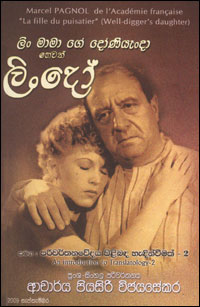Focus on Books:
Interpreting and rediscovering translation methods
Professor Sunanda Mahendra
Quite a number of translations flood into the Sinhala book market in
spite of the selection process. Most publishers, as I see it, are
fearless to sell a translated work disregarding even the basic rules
like the copyright clearance. But once in a way the Sinhala reader too
comes across certain rare works selected with clarity and significance.

The work titled Lin Mamage Doniyande hevat Lindo a French work titled
La filled u puisatier by Marcel Pagnol (1895-1974). This work is the
script or the screenplay that has gone into the making of a widely known
film by the same title produced in 1941. Translated into English this
work goes as ‘Well Digger’s Daughter’.
The translation from the original French is by Dr. Piyasiri
Wijesekara, who has earned reputation for several other works inclusive
of Albert Camus’ ‘l’etranger. Though I have not had the chance to read
some of his other translation works. I find that he has innovated some
of his own theories of translation methods.
The first part of this treatise appeared in his translation of the
work ‘Running in the Famiyl’ by Michael Ondaatje.
You may have already read about this translation as well as the first
part of the introduction to translation methods in this column several
months ago. The second part of the treatise on translations appear in
the present work of Pagnol under discussion.
All in all, Dr. Wijeseakara wants his Sinhala reader to be aware of
his dedication and the methodology. In the first instance he has
selected his source material as the screenplay by Pagnol, where the most
visible areas are the dialogues and monologues, envisages as more
folkish than classical.
The translator Wijesekara utilizes a colloquial frame of expression
founding most Sri Lankan villages, in the rural sector, than in the
urban sector. This, one may argue as to why, should be laid down as a
dogma.
But translator has an answer. ‘This is the method I utitlize and try
to follow as sensitively as possible whether the method suits you’ seems
to be the ideology held by our translator. As such, whatever the
translator says has to be initially grasped by the reader, in order to
ascertain the value embedded.
All these prefatory notes go to say that the translator Wijesekara
has embarked on a project that should be considered seriously by our
teacher s of translation methods and the professional translation of
books to the book market, what is expanding its sphere. Wijesekara uses
several methodology devices and glossarial terms in order to explain his
mission.
He makes us aware of a term denoted as translatology, which is more
than a mere method culminating in a science. He exemplifies such terms
as adaptations, linguistic diversity, anthroponomy, toponymy,
denotation, translational hegemony, linguistic colonialism,
transcription, transliteration, transformation, linguistic
decolonization, phonaesthetics and a whole horde of other terms, issues,
concepts, basic and high flown factors pertaining to his textual
material.
The finest point I observe is his use of apt Sinhala terms, mostly
deriving from Sanskrit usages. In one volume there are two texts, the
French-Sinhala translation of the screenplay text and the treatise on
translatology.
I see that Dr. Wijesekara was featured as a presenter of some
passages from his published text scheduled to have taken place on the
December 16. This presumably would help the budding trandlators to
obtain a knowledge on the process of translatogy as a discipline. The
seminar cum reading session, where I was an absentee, due to
circumstances beyond my control, I felt that the organization should be
commendable for the effort.
It was an amalgamated project of the Department of French language of
the University of Kelaniya, and the Delegation General de L’Alliance
Francais in Sri Lanka. The venue was the University of Kelaniya.
Niroshini Gunasekara whose short novella which we featured in this
column (Ou On Va Papa?) was also scheduled to be taken into discussion.
The growing interest in translations, should be supported even by the
Ministry of Cultural Affairs and the Ministry of Education, both as an
educational development and cross cultural communication study. In most
universities the Sinhala departments are either slumbering or dead. They
lack the think thank for a better curricular development. As I have
emphasized elsewhere the comparative literary studies is never taught
selecting at least a few old and new books.
They still confine themselves to a few prose and verse texts
completely hacked over the years. I sincerely feel that a new vision is
needed via a new rediscovery of literary studies. One significant need
is a literary discourse of a higher calibre of dedication. Instead of
slinging names and concepts in the name of modernity a fresh vision is
anticipated.
[email protected]
|



